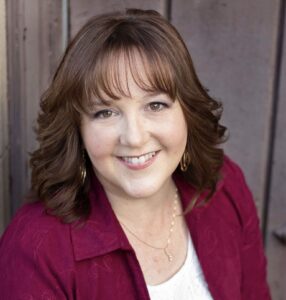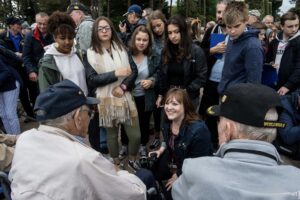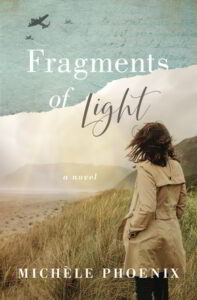A conversation with the author and TGWWF Translator, Michèle Phoenix
Everyone loves a good story. We tell stories all the time, in our everyday conversations, even on social media. As we listen to or read other people’s stories, we see where they intersect with our own, and we are changed, sometimes dramatically.
Some prefer to watch a story unfold on a screen, and some prefer curling up with a good book. Though I enjoy both, I’m partial to novels, especially historical fiction, especially if it’s well-written and well-researched. Author Michèle Phoenix’s work is just that.
When I started volunteering on The Girl Who Wore Freedom, I was captivated by the stories of the veterans, as well as those of the French people of Normandy who help preserve them. While following the progress of the film on both The Holy Post and Documentary First, I heard a familiar name – one of my favorite authors was also involved! After I recovered from a brief fan-girl moment, I reached out to the blog team to see if a conversation with the author might be possible.
 What follows is a 2-part series of questions and answers relating specifically to Michèle Phoenix’s book Fragments of Light. It’s a novel with 2 timelines – present-day and 1944. If you want to dive deeper, click on the links within the post!
What follows is a 2-part series of questions and answers relating specifically to Michèle Phoenix’s book Fragments of Light. It’s a novel with 2 timelines – present-day and 1944. If you want to dive deeper, click on the links within the post!
My first question is about the writing process. How did the idea for this story come to you?
As much as I’d like to be one of those authors who plot out their books, scene by scene, before starting the first chapter, I’m afraid I’m the opposite. A new book usually begins with a single image in my mind—a face, a location, a sound—that is so clear and so insistent that I can’t ignore it.
With Fragments of Light, it all started with a voice. I was holed up in a cabin in the far reaches of the Ozarks for three days, hoping that inspiration for book #5 would reveal itself to me as I sat in silence, without WIFI or distractions, watching bald eagles circle overhead.
After two days, as I began to doubt that anything would happen, I heard a voice—not audible to anyone else, but so real to me in its texture and tone. It was seven-year-old Lise saying, “I was dreaming about carousels the night the sky got loud.” I had no idea who she was or how carousels would fit into the story, but I got the sense that she was speaking from June 6, 1944, a child daring to be hopeful when her world told her to be scared. She had my undivided attention.
What was the timing of this idea in relation to your work on the film, TGWWF? Had you already decided to write this story before you became involved with the film?
In the spring of 2018, I’d written part of the modern-day portion of Fragments of Light—the story of a cancer survivor whose life implodes along with her healing and whose exploration of a mystery surrounding D-Day unfolds through her friendship with a quirky 74-year old fellow survivor named Darlene.
For the historical piece of the novel, I’d already written the 1944 prologue narrated by little Lise and attempted some possible plotlines, but I wasn’t satisfied with the direction it was taking.
Around the month of April, I wrote to Christian Taylor (director of The Girl Who Wore Freedom) to offer my help with translating documents for the movie. As I recall, she called me within a couple of days and asked if I’d like to meet and look over some of the footage she’d shot the year before. I gladly accepted the invitation and, as we happen to live just five miles from each other, spent a few minutes poring over the interviews of French D-Day survivors and WWII aficionados.
As we chatted, I outlined a couple of tech changes that might make it easier for her to conduct future bilingual interviews, allowing her to respond and ask follow-up questions of the French participants of the documentary in real-time, without pausing for translation.
 I thought that would be it. Then Christian called and asked me if I had any plans for the end of May, beginning of June.
I thought that would be it. Then Christian called and asked me if I had any plans for the end of May, beginning of June.
When I accepted the invitation to become the project’s translator for those weeks in France, I had no idea how that experience would inform Cal’s story in Fragments of Light. Staying in the places where the brutal battles had raged, looking into the faces of veterans as they retold their stories and entering into a relationship with the elderly French people who had watched the Allies liberate their land—it was sobering, galvanizing and inspiring. I’ve scattered their faces and names across the pages of this novel.
Your work, especially in the main character’s cancer struggle, has autobiographical elements. How did you decide to incorporate Cecelia’s struggle with cancer into a story of D-day?
I’m a two-time breast cancer survivor.
Honestly, I’m grateful that as a society we’ve become so much better at openly discussing the disease. We recognize the courage of life-altering decisions about surgeries and treatments. We celebrate those who are fighting it with fundraisers and bumper stickers and pink ribbons. But we still fall short in sufficiently recognizing the toll a medical crisis can take not only on the patient but on the loved one walking alongside her.
 That’s why I wanted to address the disease in Fragments of Light. It’s also why I brought her husband Nate into the story. As painful as Ceelie’s own journey is, the parallel path Nate takes changes him too. He has my heart. I love his courage, confusion, vulnerability, and determination. He embodies the too-often-ignored attrition of caregivers whose role in a patient’s survival can be just as taxing, though in different ways.
That’s why I wanted to address the disease in Fragments of Light. It’s also why I brought her husband Nate into the story. As painful as Ceelie’s own journey is, the parallel path Nate takes changes him too. He has my heart. I love his courage, confusion, vulnerability, and determination. He embodies the too-often-ignored attrition of caregivers whose role in a patient’s survival can be just as taxing, though in different ways.
This book is published as Christian fiction, but none of the living characters speak of their faith, yet the themes of redemption and forgiveness are strong. How did you decide to let faith take a more subtle role in this novel?
I wanted this book to have universal themes—to feel accessible to a broader audience than “Christian fiction” usually reaches. Redemption and forgiveness are certainly key tenets of the faith, but they’re essential to any life well-lived and meaningful. My own journey toward healing and wholeness would not have been possible without a decision to move on from injury with forgiveness and hope. My faith played a key role in that, as I mention in the Author’s Note at the end of the book. If this novel expresses that sense of possibility to others, I trust it will also point them to the One who redeems.
Be sure to check back next week for a continuation of this conversation with author and TGWWF translator, Michèle Phoenix.
This post was authored by:


Laura- A wonderful conversation with Michéle! Thank you. I am saving my reading of Fragments of Light for just the right undistracted moment sometime in the next month or so. Can’t wait! -Janie Miller
Thanks for faithfully reading and commenting, Janie!